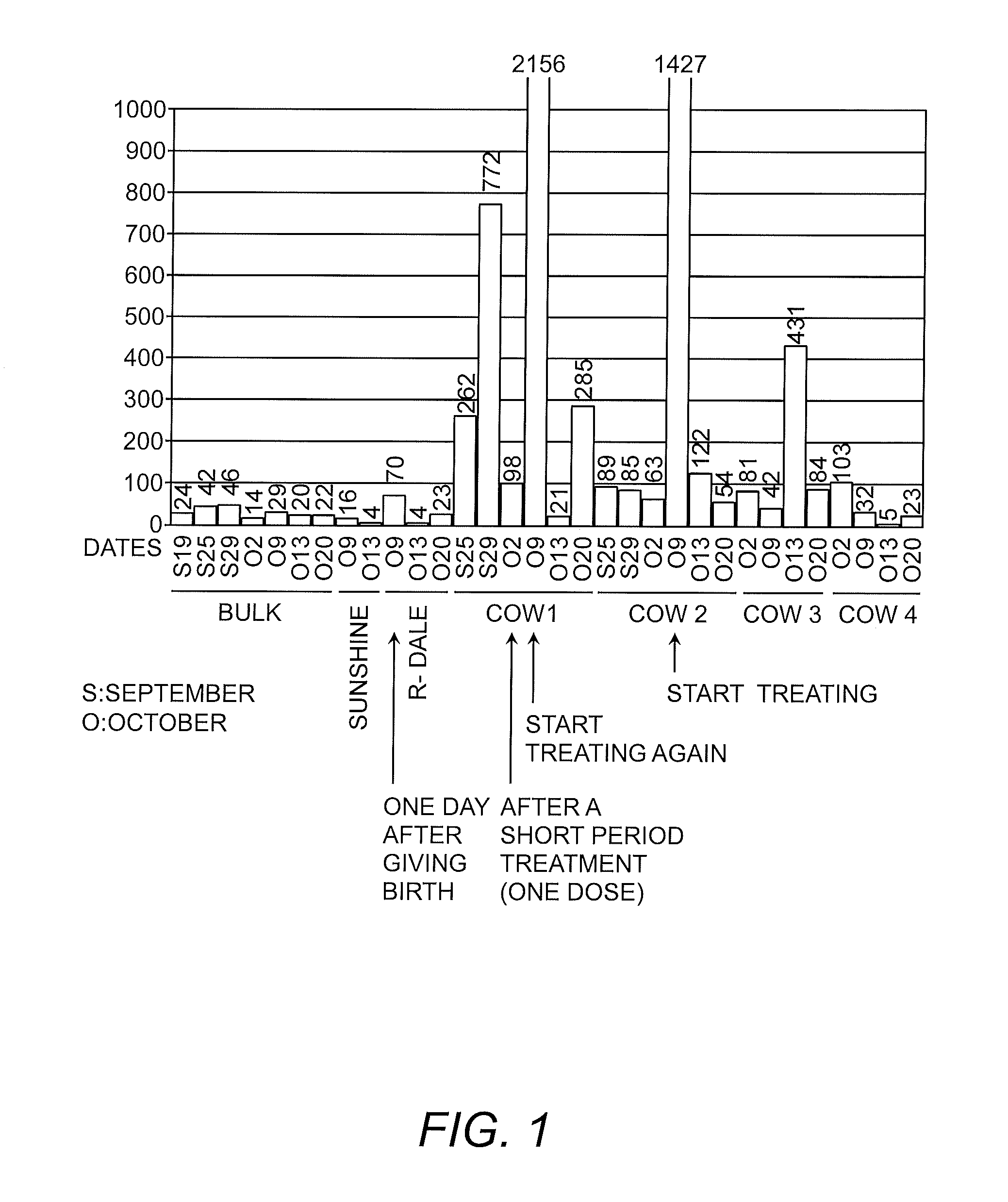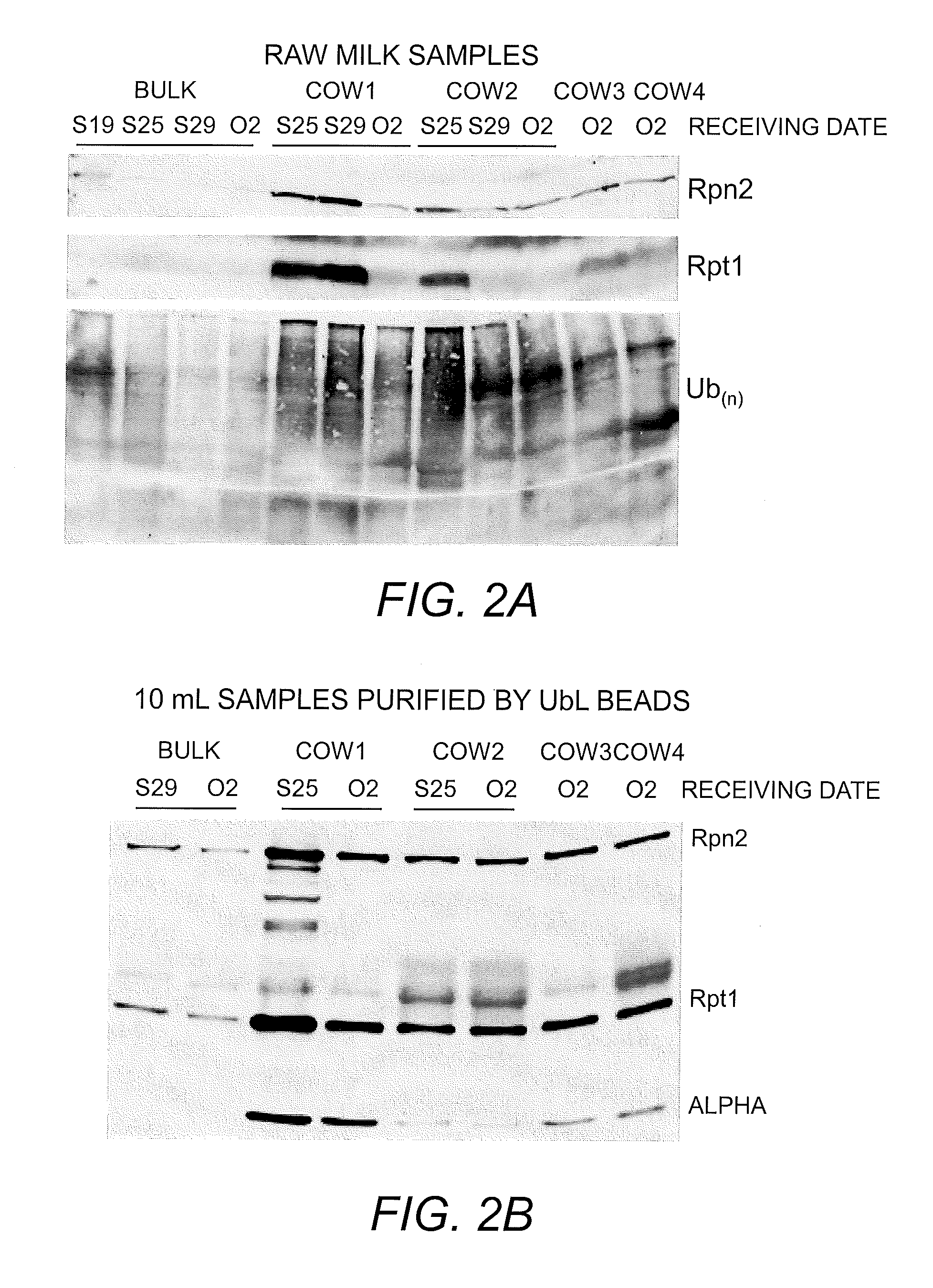Methods and kits for detecting mastitis
a technology for detecting kits and mastitis, which is applied in chemical methods analysis, instruments, biochemistry apparatus and processes, etc., can solve the problems of not knowing if yeast/fungi can aggravate the infection caused by coincident, affecting the quality of the entire milk output of a dairy facility, and the milking process itself is highly conduciv
- Summary
- Abstract
- Description
- Claims
- Application Information
AI Technical Summary
Benefits of technology
Problems solved by technology
Method used
Image
Examples
example 1
Application of Proteasome Assays to Detecting Mastitis
[0084]The methods and systems provided are particularly useful for the early detection of mastitis and monitoring or treatment for various milk producing animals such as the dairy cow. However, the methods are broadly applicable to other organisms, including human, and to other conditions such as malignant growth and pathology. The method involves detecting the abundance and activity of the ubiquitin / proteasome pathway in a sample of unprocessed (raw) milk, wherein an increase in proteasome activity in the sample, as compared to a control, is indicative of mastitis. The invention also includes detecting the level of ancillary proteins of the ubiquitin / proteasome pathway and of the immunoproteasome. In a different embodiment of this invention the mRNA expression of components of the ubiquitin / proteasome pathway are measured using variations of polymerase chain reaction-based amplification. Oligonucleotide-based detection of releas...
example 2
Proteasome Activity in Raw Milk
[0094]Raw milk samples were obtained from a local farm once a week for 16 consecutive weeks. Samples (approximately 30 ml) were collected from the daily first milking (about 5:00 am) and then stored on ice. All samples were collected by 8:30 am, and processed for proteasome activity by 10:30 am. Proteasome activity was determined at 37° C. with the fluorogenic substrate Suc-LLVY-AMC (SEQ ID NO:2), and quantified using a TURNER 7000 fluorometer. Overall protein concentration was highly uniform, and reflected the very high levels of casein and other abundant milk proteins. Therefore, a volume-based assay was most reliable. The results of this analysis are presented in FIG. 1.
[0095]In the first set of seven columns of FIG. 1, the level of proteasome activity was measured in triplicate from samples taken from the bulk reservoir (maintained at 10° C.). Milk in this reservoir represented the collective output from approximately 50 cows. Typically, the reserv...
example 3
Assays for Determining Proteasome Activity
[0106]To monitor chymotryptic, tryptic and caspase-like activities as an indication of proteasome activity, labeled substrates specific for one or more proteases can be used. To determined proteasome subunit abundance, high-affinity immunologic methods were used. To detect de-ubiquitylation activity, the levels of ubiquitin, multi-ubiquitin, and ubiquitinated substrates can be determined using immunologic methods. Alternatively, the assembly of catalytically active 26S proteasomes, from its component 19S and 20S particles, can be measured. The level of the ‘Immunoproteasome’ and the associated PA28 / 13S complex, and novel 20S catalytic particle, can be determined using immunologic methods.
PUM
 Login to View More
Login to View More Abstract
Description
Claims
Application Information
 Login to View More
Login to View More - R&D
- Intellectual Property
- Life Sciences
- Materials
- Tech Scout
- Unparalleled Data Quality
- Higher Quality Content
- 60% Fewer Hallucinations
Browse by: Latest US Patents, China's latest patents, Technical Efficacy Thesaurus, Application Domain, Technology Topic, Popular Technical Reports.
© 2025 PatSnap. All rights reserved.Legal|Privacy policy|Modern Slavery Act Transparency Statement|Sitemap|About US| Contact US: help@patsnap.com



